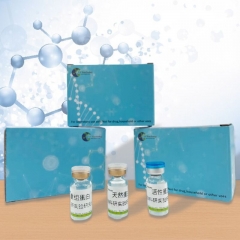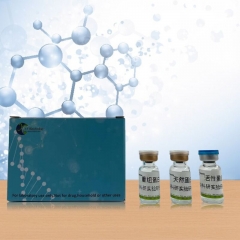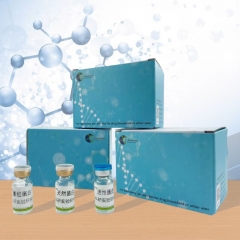Active Monocyte Chemotactic Protein 1 (MCP1)
单核细胞趋化蛋白1(MCP1)活性蛋白
[ PROPERTIES ]
Source: Prokaryotic expression. Host: E. coli
Residues: Gln24~Thr99
Tags: N-terminal His-tag
Purity: >92%
Endotoxin Level: <1.0EU per 1μg (determined by the LAL method). Buffer Formulation: 20mM Tris, 150mM NaCl, pH8.0, containing 0.01% skl, 5%Trehalose. Applications: Cell culture; Activity Assays; In vivo assays. (May be suitable for use in other assays to be determined by the end user.)
Predicted isoelectric point: 9.4
Predicted Molecular Mass: 9.5kDa
Accurate Molecular Mass: 15&17kDa as determined by SDS-PAGE reducing
conditions. Phenomenon explanation:
The possible reasons that the actual band size differs from the predicted are as follows:
1. Splice variants: Alternative splicing may create different sized proteins from the same gene. 2. Relative charge: The composition of amino acids may affects the charge of the protein. 3. Post-translational modification: Phosphorylation, glycosylation, methylation etc. 4. Post-translation cleavage: Many proteins are synthesized as pro-proteins, and then cleaved to
give the active form. 5. Polymerization of the target protein: Dimerization, multimerization etc.
[ USAGE ]
Reconstitute in 20mM Tris, 150mM NaCl (pH8.0) to a concentration of 0.1-1.0mg/mL. Do not vortex.
[ STORAGE AND STABILITY ]
Storage: Avoid repeated freeze/thaw cycles.
Store at 2-8ºC for one month.
Aliquot and store at -80ºC for 12 months.
Stability Test: The thermal stability is described by the loss rate. The loss rate was determined by accelerated thermal degradation test, that is, incubate the protein at 37ºCfor 48h, and no obvious degradation and precipitation were observed. The loss rate is less than 5% within the expiration date under appropriate storage condition.
[ SEQUENCE ]

[ ACTIVITY ]
MCP-1 (monocyte chemoattractant protein 1), also known as CCL2 (C-C motif chemokine 2), is a small cytokine that belongs to the CC chemokine family. MCP-1 has been described as a chemoattractant for monocytes and proven to be able to induce chemotactic migration of THP-1 cells. Therefore, chemotaxis assay used 24-well microchemotaxis system was undertaken to detect the chemotactic effect of MCP-1 on the human monocytic cell line THP-1. Briefly, THP-1 cells were seeded into the upper chambers (100uL cell suspension,10 6cells/mL in RPMI 1640 with 0.5% FBS) and MCP-1 (25ng/mL and 50ng/mL diluted separately in serum free RPMI 1640) was added in lower chamber with a polycarbonate filter (8um pore size) used to separate the two compartments. After incubation at 37ºCwith 5% CO2 for 3h, the filter was removed, then cells in low chamber were observed by inverted microscope at low magnification (×100) and the number of migrated cells were counted at high magnification (×400) randomly (five fields for each filter).
Result: MCP-1 is able to induce migration of THP-1 cells. The migrated THP-1 cells in low chamber at low magnification (×100) were shown in Figure 1. Five fields of each chamber were randomly chosen, and the migrated cells were counted at high magnification (×400). Statistical result were shown in Figure 2. The optimum chemotactic concentration of MCP-1 is about 25ng/mL, which is in accordance with references.
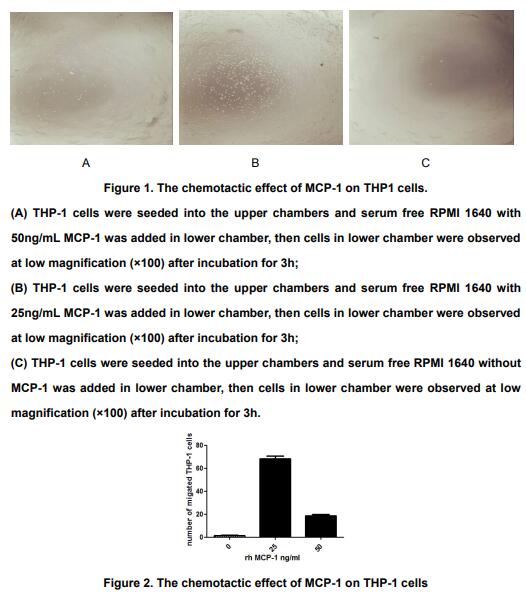
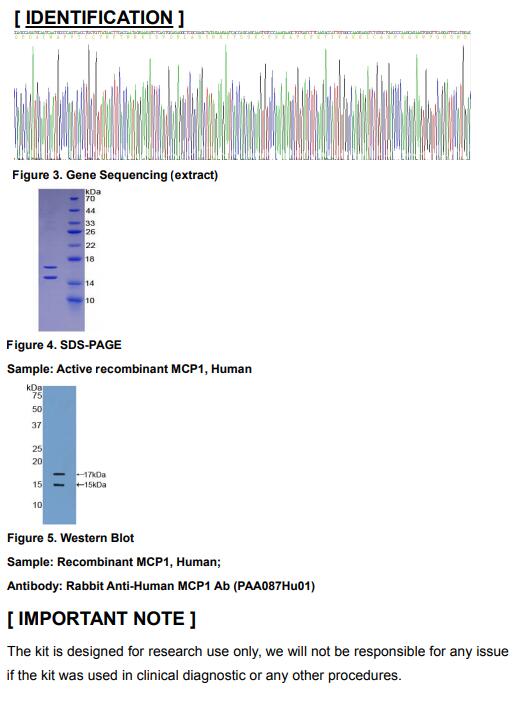
 在线客服1号
在线客服1号






